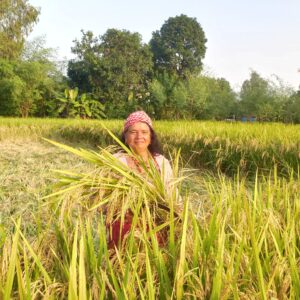CGIAR Centers manage some of the oldest, largest, and most diverse collections of staple food crops in the world that are held in-trust as global public goods. Together, they include more than 700,000 seed accessions stored in 27 crop collections at 10 CGIAR Centers, The diversity in the collections underpins CGIAR’s research and breeding efforts and is shared upon request to users worldwide. Thus, the CGIAR genebanks play an important part in the delivery of improved crop varieties to meet wide-ranging goals to alleviate poverty, improve food and nutrition security, and address climate change.
The need for diverse germplasm adapted to different environments was recognised nationally in the late-19th century by Russia and the USA, both with large land masses suitable for improved agriculture. In 1894, Russia established its Bureau of Applied Botany to collect and study crop diversity, which quickly collected germplasm from within Russia and received other material from Canada and Sweden.
By 1921, it had become the Department of Applied Botany and Plant Breeding (later, the All-Union Institute of Plant Industry) led by N.I. Vavilov. Its scientists collected and studied plant germplasm from across five continents. Similarly, in 1898, the United States Department of Agriculture (USDA) created its Section of Seed Production and Introduction and despatched seed collectors globally.
In that first year, new durum and bread wheat varieties were collected from Russia and introduced successfully into the USA, such that, within five years, USA wheat production had increased from 60,000 to 20 million bushels a year. Both countries subsequently introduced seed stores to maintain their germplasm collections. The USDA opened the National Seed Storage Laboratory in 1958 dedicated to this task as a keystone of the USDA germplasm system.
The growing importance of germplasm to improve crop varieties to support the burgeoning world population after World War 2, the simultaneous loss of that germplasm by genetic erosion, and the growing understanding of the relevance of genebanks, led to international action.
The International Board for Plant Genetic Resources (IBPGR) was created in 1974 and soon released recommendations on standards for long-term genetic resources conservation, detailed advice on the design of long-term seed stores , and protocols to germinate samples from seeds held in long-term storage to monitor their viability.
By the end of its first decade, IBPGR was able to celebrate a network of 113 significant plant germplasm collections, including those of CGIAR.
CGIAR was founded in 1971 as a global research partnership aiming to tackle the food crisis affecting many countries in the developing world. Today, the CGIAR Centers manage some of the oldest, largest and most diverse collections of staple food crops in the world that are held in-trust as global public goods.
Together, they include more than 700,000 seed accessions stored in 27 crop collections at 10 CGIAR Centers, and further collections of tissue culture and live plants. The diversity in the collections underpins CGIAR’s research and breeding efforts and is shared upon request to users worldwide. Thus, the CGIAR genebanks play an important part in the delivery of improved crop varieties to meet wide-ranging goals to alleviate poverty, improve food and nutrition security, and address climate change.
To be effective, genebanks need to ensure that the seed samples representing each and every accession are in a healthy state when put into storage and maintain high viability on a long-term basis. However, each plant species shows individual seed behaviour and differ in the period (by decades) they remain viable in storage.
In theory, as soon as seed viability falls to a certain threshold (typically 85%), accession regeneration should be triggered so that new stocks are generated for storage and use.
‘Active management’ (i.e. further viability monitoring) of the low viability lot then ceases and it should be discarded unless it is still considered suitable for distribution (or for research, for example, as discussed later, to better understand longevity in storage). In this way, for each accession, no more than one seed lot in the active collection and one seed lot in the base collection should be under active management at any one time.
However, early on, it was recognised that the task to monitor the considerable number of seed accessions of diverse genotypes, including crop wild relatives, was not trivial. Furthermore, it was concluded that “many genebanks continue to place seeds in storage without adequate testing and many have not properly established routine monitoring regimes”.
CGIAR genebanks have amassed a large quantity of viability monitoring data over the last few decades. However, although it is clear that high viability can be maintained over 30 years or longer for some seed lots of many of the crops they conserve, it is nonetheless difficult to make reliable estimates of seed lot longevity that would be meaningful in terms of revising monitoring intervals and predicting future levels of accession rejuvenation. Overall, the data suggest that a ‘steady state’ of operations has not been reached, with genebanks having faced considerable constraints; management focus has varied depending on the uppermost priorities at different times.
We emphasize, that we do not believe that these constraints have resulted in loss of unique germplasm, rather that the efficiencies that could have been made as a result of seed longevity analyses such as these are restricted by the paucity of reliable historical data. Despite this, seed genebanking, and specifically the overall framework of how collections should be stored and managed, remains the most effective way of ensuring the availability of viable crop germplasm for future generations as a means of contributing to global food security.
Raed the study:
Hay FR, Whitehouse KJ, Ellis RH, Sackville Hamilton NR, Lusty C, Ndjiondjop MN, Tia D, Wenzl P, Santos LG, Yazbek M, Azevedo VCR, Peerzada OH, Abberton M, Oyatomi O, Guzman F, Capilit G, Muchugi A, Kinyanjui, Z. (2021) CGIAR genebank viability data reveal inconsistencies in seed collection management. Global Food Security, Volume 30.






